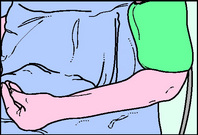Chapter 2 The general examination
The examination really begins from the moment you set eyes on the patient. Facial expression, tone of voice and body attitude may signal depression, even if the patient does not complain of feeling depressed.
GENERAL EXAMINATION: FIRST IMPRESSIONS
Short stature may reflect constitutional shortness, a distinct genetic syndrome or the consequence of intrauterine, childhood or adolescent growth retardation.
THE EYE
RECOGNISABLE SYNDROMES AND FACIES
ENDOCRINE SYNDROMES
It is practical to consider the examination of the endocrine glands in the context of the overall general examination.
Clinical examination of the thyroid gland
Hypoparathyroidism
Surgical damage or removal of three of four parathyroid glands during neck surgery (usually thyroidectomy) is the most common cause of hypoparathyroidism. The serum calcium level is low (in the presence of a normal serum albumin). The major symptoms of acute hypoparathyroidism are paraesthesiae around the mouth, fingers and toes. Abnormal nerve and muscle irritability can be elicited with Chvostek’s (Fig. 2.1) and Trousseau’s signs (Fig. 2.2).
Hyperadrenalism (Cushing’s syndrome)
 Differential diagnosis: Hyperadrenalism
Differential diagnosis: Hyperadrenalism
 Symptoms and signs: Observation of general appearance
Symptoms and signs: Observation of general appearance Symptoms and signs: Quick testing of visual acuity
Symptoms and signs: Quick testing of visual acuity Differential diagnosis: Main causes of red eye
Differential diagnosis: Main causes of red eye Symptoms and signs: Penlight inspection of the red eye
Symptoms and signs: Penlight inspection of the red eye Red flag – urgent referral: Indications for emergency referral to ophthalmology
Red flag – urgent referral: Indications for emergency referral to ophthalmology Symptoms and signs: Down’s syndrome (trisomy 21)
Symptoms and signs: Down’s syndrome (trisomy 21) Questions to ask: Hyperthyroidism
Questions to ask: Hyperthyroidism Symptoms and signs: Hyperthyroidism
Symptoms and signs: Hyperthyroidism Symptoms and signs: Graves’ disease (autoimmune hyperthyroidism)
Symptoms and signs: Graves’ disease (autoimmune hyperthyroidism) Questions to ask: Hypothyroidism
Questions to ask: Hypothyroidism Symptoms and signs: Hypothyroidism
Symptoms and signs: Hypothyroidism Differential diagnosis: Hypothyroidism
Differential diagnosis: Hypothyroidism

 Symptoms and signs: Cushing’s syndrome
Symptoms and signs: Cushing’s syndrome Symptoms and signs: Presenting features of acute adrenal (Addisonian) crisis
Symptoms and signs: Presenting features of acute adrenal (Addisonian) crisis


